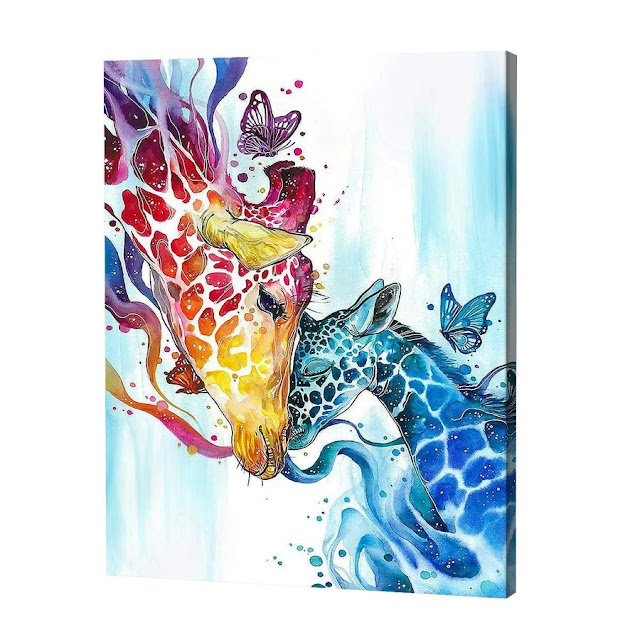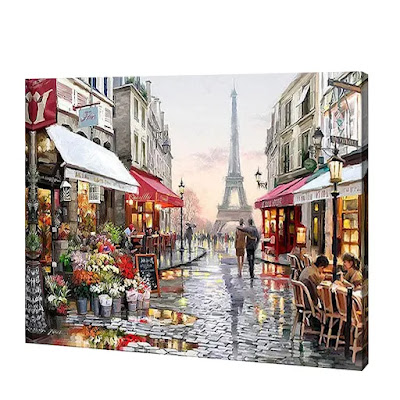How Painting by Numbers Activates Your Brain’s Reward System
With stress, anxiety, and overstimulation part of daily modern life, it is no wonder more and more people are choosing to find relief through mindful activities, often of a creative kind. In an article published last September in the Atlantic, it was noted that painting by numbers is returning to popularity among all age groups. Beyond the fact that painting by numbers is a calming and enjoyable pastime, there is science behind why it feels so good when we paint. Neuroscience research shows that creating art engages the brain's reward system, with an influx of feel-good chemicals like dopamine coursing through it, the very neurotransmitter that is associated with motivation, pleasure, and satisfaction.
So, how exactly does Painting by Numbers activate this response? And why does something so simple seem to fulfill us so much, and make us feel relaxed, accomplished, and just plain happy? In this blog post we will take a look at the brain's reward system and explain how picking up a paintbrush to paint- particularly guided, easy art like painting by numbers- could be one of the easiest and most enjoyable ways to engage it.
Understanding the Brain’s Reward System
Dopamine, a serotonin receptor that helps regulate emotional reactions and acknowledges pleasurable experiences, is at the centre of the reward system in your brain. During an enjoyable experience (i.e., eating nice food, achieving a goal, or getting praised), dopamine is emitted, which makes it more likely that you will want to repeat this action.
The behavior that is guided by the reward system can end up forming habits so you will be motivated to engage in fulfilling actions. This is literally why once you engage in an enjoyable action, your brain will remember the enjoyable feeling, and encourage you to do it again.
Creative tasks - especially those that are embodied, like painting- have been shown to stimulate the reward system. The repetitive action of moving the brush, intense attention to detail, and feeling of progress in a painting set this activity up to stimulate that pathway.
Why Painting by Numbers Works So Well
Painting by Numbers is distinctly poised to optimise this neurochemical stimulus because it provides three triggers for the release of dopamine:
Clear Goals and Instant Feedback - You have a pre-determined task (paint the area numbered according to the color prompt). Once you finish a section, you instantly see the results. This quick visual feedback creates a small "win," increases motivation.
Visible Progression - Watching a blank canvas slowly reveal itself into a detailed piece of art creates a strong visceral sense of progression. Each section you complete makes you want to keep going, and makes the brain want to release dopamine with each new milestone.
Little Risk and High Reward Creativity - This format removes any fear of failure because the design and colours are already predetermined. This framework removes pressures and anxiety, allowing you to simply enjoy the act of creatio, and feel proud of the result.
The Joy of Completion and Mastery
Accomplishing a task is a huge dopamine driver. Our brains are programmed for closure, which is why completing a puzzle and crossing it off a to-do list feels so good. With Painting by Numbers, that last stroke or colour provides a sense of completion that is rewarding.
Even before completing the painting, every area you fill in provides a sense of accomplishment. These little wins create a perpetual dopamine loop, driving motivation and your desire to keep going. It is a brain hack that keeps you focused and increases your mood organically.
Personalized Projects, Personalized Rewards
While structured painting activities can activate the reward system, personalized painting by numbers elevates it to the next level. Personalized painting by numbers turns your own images—like a family photo, your pet, or a snapshot from a vacation—into paint by number canvas. Because you have a deeper connection to the item you're painting, the reward you experience in the process becomes even more meaningful.
When you are painting something familiar or that has sentimental value, the brain associates the task with positive memories. That combination of stimulation—nostalgia and creativity—amplifies the dopamine release and creates an experience that is therapeutic and fun.
Engaging Multiple Brain Regions
Painting stimulates several different brain regions in addition to the dopamine-driven reward prefrontal cortex system.
Prefrontal Cortex: The prefrontal cortex is in charge of concentration, planning, and decision-making. This area aids in maintaining mental focus and attentiveness when painting.
Parietal Lobe: Hand-eye coordination and spatial awareness are processed here. This part of the brain is fine-tuned by holding a brush, lining it up with the numbered sections, and applying paint. The temporal lobe is linked to memory and emotion processing. The temporal lobe becomes even more active while working on personalised painting by numbers, bringing up emotional memories and increasing your sense of fulfilment.
These overlapping brain functions cooperate to provide cognitive stimulation which is an extra advantage particularly for aging brains in addition to making the activity enjoyable.
The Role of Flow State
Another psychological phenomenon that is related to dopamine release is flow state, which is a state characterized by intense concentration and immersion, during which time disappears. In flow, people typically feel a sense of effortless control, joy, and complete engagement. It is very rewarding, and often described as euphoric.
Painting by Numbers is great for inducing flow. Although painting the image is a little challenging, it is not stressful enough to be frustrating. As you move from one color-section to the next, your focus sharpens, breathing slows, and you are completely absorbed. This full absorption not only activates dopamine, but it reduces stress inducing hormones like cortisol.
Mental Health Benefits Backed by Brain Chemistry
Engaging the reward system by painting is not only about feeling good, but it is also quite healthy mentally. Studies show that activities that increase dopamine levels can ease depressive symptoms, anxiety, and feelings of low self-worth.
People who paint regularly have better sleep, improved mood and are more patient. For people recovering from illness, going through grief, or experiencing stress, painting becomes a meaningful way to practice emotional self-care (not a replacement for professional help, but a meaningful supplement).
Painting also promotes neuroplasticity in older adults (the brain's ability to reorganise itself and make new connections), which helps preserve cognitive health over time.
A Natural Alternative to Digital Dopamine Hits
Our brains are looking for quick dopamine hits in a world bombarded with digital stimulation - likes on social media, video games, short-form videos - these quick dopamine hits are found with these fast paced sources, but have often lead to overstimulation, mental drain, and decreased attention spans.
Painting by Numbers is a slower, more fulfilling alternative to those artificial triggers. Instead, you earn your dopamine layers of focus and patience, along with being creative. It is a much better way to engage our brain's reward system without the mental crash that typically follows our screen time.
Final Thoughts
Our brains are conditioned to move toward rewarding experiences, and Painting by Numbers provides rewarding experiences in a safe, creative and emotionally restorative way. The activity of Painting by Numbers combines structure with creativity that stimulates the brain
areas associated with pleasure, focus, and motivation. Each brushstroke not only adds to the artwork but also supports your mental wellbeing.
When you are engaging with a basic kit or a personalized painting by numbers activity, it is more than paint, it is a flash of creativity and brain fuel! So the next time you feel stressed, bored or just need a mental and emotional boost, get out a paintbrush! Your brain and heart will thank you.




Comments
Post a Comment